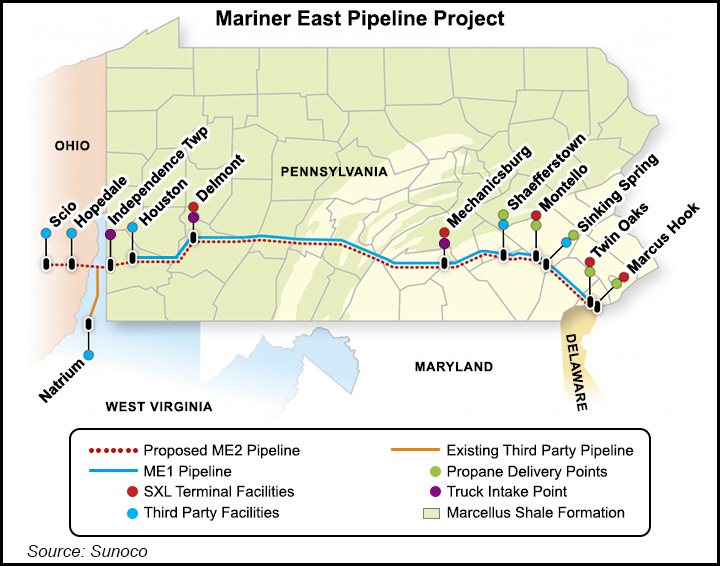Regulatory | Infrastructure | NGI All News Access | NGI The Weekly Gas Market Report
Another Battle to Stop Mariner East Operations Underway
Sunoco Pipeline LP is fighting another emergency petition filed by seven Pennsylvania residents with the state Public Utility Commission (PUC) to stop operations on the entire Mariner East (ME) system.

Residents from Delaware and Chester counties in the southeast part of the state, where construction spills, water issues and sinkholes have raised public alarm and slowed down Sunoco’s ME 2 and 2X projects, filed the emergency petition and formal complaint on Nov. 19.
The move could once again halt operations on ME 1, an old oil pipeline that was converted and entered full service in 2016 to deliver 70,000 b/d of natural gas liquids (NGL) from one side of the state to the other; stop what little construction is left on the remaining projects; and jeopardize a workaround that Sunoco crafted to get part of ME 2 online by the end of the year.
The petitioners argue that operations and construction must be halted so that the PUC can review Sunoco’s public awareness program, which they say is required by federal regulations to direct the public on how to deal with the possibility of a major leak or rupture. Petitioners said the current program is inadequate, arguing that the hazardous liquids lines pose the greatest threat of “injury, death and property damage,” compared to other kinds of infrastructure.
PUC spokesman Nils Hagen Frederiksen said there’s a “very specific timetable” for dealing with emergency petitions. Hearings before the commission’s Office of Administrative Law Judge (ALJ) have already been scheduled for Thursday (Nov. 29) and Friday (Nov. 30).
The ALJ’s order to grant or deny the petition is due within 15 days of the filing. If granted, the order would go into effect immediately without a vote before the entire Commission. The matter would then go to the full Commission for review, threatening another prolonged stoppage of ME’s operations during that time.
An ALJ halted ME 1 operations and ME 2 and 2X construction in May when state Sen. Andrew Dinniman filed an emergency petition and complaint questioning the safety of the entire system after sinkholes formed near the project in a heavily populated area. ME 1, which is currently in operation, has been offline for nearly three months this year due to that suspension and another related to the sinkholes earlier this year.
Sunoco, a subsidiary of Energy Transfer LP, started commissioning part of the ME 2 system this month, when line fill got underway. The pipeline was initially slated to come online about two years ago.
Facing consistent delays, the company repurposed a 12-inch diameter pipeline that carried refined products so it could tap into parts of the 20-inch diameter ME 2 near West Whiteland Township in Chester County that have been completed and are unaffected by regulatory issues. Energy Transfer management said earlier this month that it now expects ME 2 to be partially in-service by the end of the year.
“In an abrupt but unannounced change of terminology, Sunoco has begun referring to this cobbled-together hybrid pipeline as ME 2,” the residents said in their petition.
It’s unclear how using the repurposed line might affect capacity on ME 2, which on its own was designed to move 275,000 b/d. The PUC is already investigating a leak of tens of thousands of gallons of gasoline from the repurposed line.
In any event, it became clear in July when the fix was announced that Sunoco needed to meet its customer obligations, as the project’s ongoing regulatory issues and other related service interruptions on ME 1 were forcing producers to find costly workarounds.
Indeed, ME 1 anchor shipper Range Resources Corp. filed on Tuesday to intervene in the latest proceedings, arguing that operations on that pipeline should not be stopped because the PUC conducted a thorough investigation after the sinkholes formed near it earlier this year that concluded NGLs could safely be transported.
Service on the 250,000 b/d ME 2X is now expected to start in 3Q2019. There is still some construction left to be finished on that pipeline and ME 2, an Energy Transfer spokesperson told NGI’s Shale Daily earlier this month.
ME 2 and 2X would run parallel for about 350 miles to move ethane, butane and propane from processing facilities in Ohio, Pennsylvania and West Virginia to the Marcus Hook Industrial Complex near Philadelphia.
© 2024 Natural Gas Intelligence. All rights reserved.
ISSN © 1532-1231 | ISSN © 2577-9877 | ISSN © 1532-1266 |
